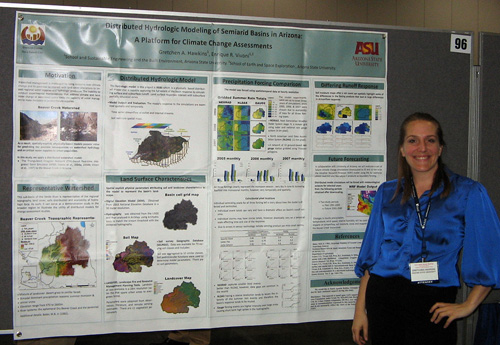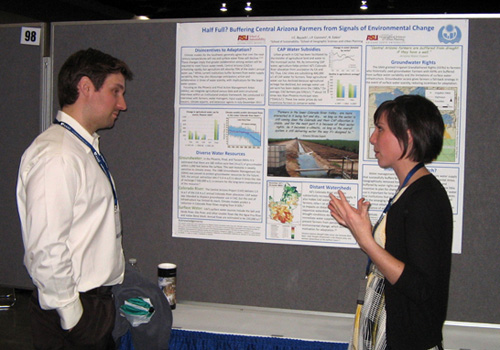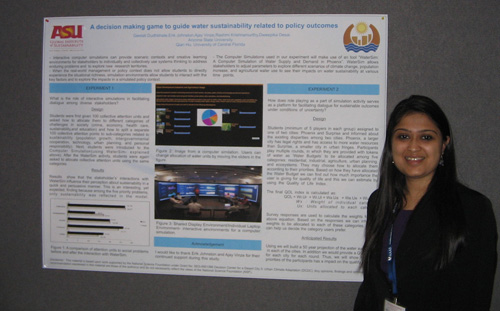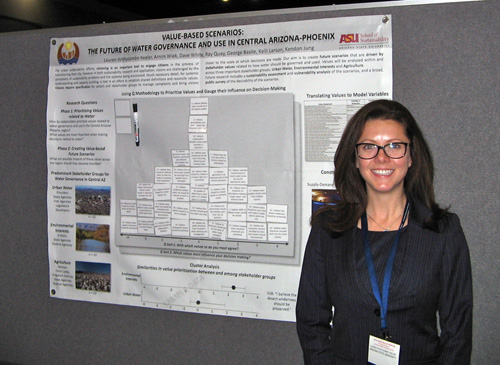February 8, 2012
Graduate students from the Decision Center for a Desert City's Community of Graduate Research Scholars will present their research at the AAAS Annual Meeting in Vancouver on February 19. They will be accompanied by DCDC Co-PI Margaret Nelson and DCDC Associate Director, Dave White. The American Association for the Advancement of Science (AAAS), is an international non-profit organization dedicated to advancing science around the world by serving as an educator, leader, spokesperson and professional association.
DCDC Graduate Research Assistant, Lauren Keeler, will have the opportunity stand in on behalf of DCDC Researcher Dr. Arnim Wiek in a session on climate change visualization and communication, entitled, Beyond Climate Models: Rethinking How To Envision the Future with Climate Change.
Lauren will be speaking for a few minutes on ASU's Decision Theater and the ability of tools like it to engage people in thinking about climate change and future uncertainty. She will also speak about the need to merry such tools with strong stakeholder engagement processes in order to bring our research closer to relevant decision making scales.
After Lauren's presentation, she will facilitate a breakout group discussion on the potential for decision theaters to improve climate change communication and knowledge among decision makers and the general public.
DCDC Graduate Research Assistants participating in the February 19 AAAS General Poster Session include:
Rebecca Neel, DCDC Graduate Research Assistant Status, Family, Sex, and Good Neighbors: Landscaping Conveys Personality
Status, Family, Sex, and Good Neighbors: Landscaping Conveys Personality
Do people use their lawns to look sexy, high status, and family friendly? Previous research shows that recycling and taking public transportation, among other behaviors, can convey a less positive or desirable image, which may prove a barrier to behavior change. We extended this research to examine the image that landscaping portrays for a sample from Phoenix, Arizona, where water resources are scarce and homeowners’ landscaping options range from the water-intensive (grass lawns) to more water-conserving (desert plants and rocks). We hypothesized that owners’ grass or desert landscape choices are seen to convey very different personalities. Across three samples, participants rated the personality characteristics of a new homeowner on dimensions of agreeableness, being a good neighbor, status, sexual attractiveness, family orientation, creativity, prosociality, environmentalism, Big Five personality ratings, and positivity. Participants were randomly assigned to read that the person in question chose either a desert or a grass lawn for their new home. Inferred motivations for choosing desert or grass were also measured. We found consensus among participants that a desert landscape conveys a lower-status, less sexually attractive, family-unfriendly image–suggesting that even among those who might see people with desert landscaping as fine neighbors, they still perceive those individuals to be lower status and not family-oriented. Perceived motivations largely corroborated perceived attributes: Whereas aesthetic preference was perceived as the primary motivation for choosing either a desert or lawn landscape, secondary motivations differed. Desert landscaping was perceived to be more motivated by environmentalism, money savings, and ease of maintenance, whereas grass landscaping was perceived to reflect a desire to interact with one’s neighbors and to raise a family. Our choice of lawn may thus convey much to our neighbors about both our own quality as a neighbor and community member. To the extent that landscaping paints the image of a relatively unfriendly, low-status, unsexy or child-averse person, inferences may prove a barrier to encouraging native landscape adoption, as making such a choice might not only incur a financial cost in the value of the home, but a concurrent cost in self-image.
Lauren Withycombe Keeler, DCDC Graduate Research Assistant
Selecting and Assessing Distinct Scenarios for Sustainable Water Governance Strategies
Sustainable water governance strategies and policy need to be guided by a comprehensive vision of a sustainable water system and account for uncertainty through robust performance against a spectrum of distinct future scenarios. Climate and water science in general have made significant progress over the last years in understanding the complexity of regional climate-water systems, progress well exemplified by the work of the Decision Center for a Desert City (DCDC) at Arizona State University. This success has been demonstrated through the development of sophisticated system dynamics models elaborated further by including energy and econometric models, such as the WaterSim model from DCDC. However, dynamic models in general, and WaterSim in particular, have been limited in their application and not fully utilized for policy-making and governance. Reasons for this limited applicability include: dynamic water-climate models are not generally used to construct distinct, recognizable futures scenarios (such as the IPCC stress scenarios); water-climate models are still evaluated on their ability to forecast the future which limits their scope and potential to guide planning; results of the model are often not evaluated against a comprehensive set of criteria; and finally, dynamic models are often not used to their full potential in a constructive way, to develop future pathways and strategies. To address these deficits in water-climate models and enhance the usability of the WaterSim model, plausible future scenarios were constructed based on stakeholder and decision maker input and output from WaterSim that includes external social and natural factors of uncertainty (e.g., long-term drought, growth, and climate change). Results include a set of 5 distinct, recognizable future scenarios that identify critical key factors and policies that serve to guide decision-making related to water and conceptualize the systemic consequences of water management and mismanagement beyond groundwater overdraft. The scenarios explicate the possible impacts of climate change as well as resource management and economic development decisions at the municipality and metropolitan scales in Central Arizona. In this way, the scenarios contribute to further scientific and political dialogue regarding water management in the face of climate change and close the gap between scientific knowledge about climate change impacts and the adaptive capacity of decision makers.
 Gretchen Hawkins, DCDC Graduate Research Assistant
Gretchen Hawkins, DCDC Graduate Research Assistant
Distributed Hydrologic Modeling of the Beaver Creek Watershed: A Platform for Land Cover and Climate Change Assessments
Watershed management is challenged by rising concerns over climate change and its potential to interact with land cover alterations to impact regional water supplies and hydrologic processes. The inability to conduct experimental manipulations that address climate and land cover change at watershed scales limits the capacity of water managers to make decisions to protect future supplies. As a result, spatially-explicit, physically-based models possess value for predicting the possible consequences on watershed hydrology. In this study, we apply a distributed watershed model, the Triangulated Irregular Network (TIN)-based Real-time Integrated Basin Simulator (tRIBS), to the Beaver Creek basin in Arizona. This sub-basin of the Verde River is representative of the regional topography, land cover, soils distribution and availability of hydrologic data. As such, it can serve as a demonstration study in the broader region to illustrate the utility of distributed models for change assessment studies. Through a model application to summertime conditions, we compare the hydrologic response to two sources of meteorological input: (1) an available network of ground-based stations and (2) weather radar rainfall estimates. Comparisons focus on the spatiotemporal distribution of precipitation, soil moisture, runoff generation, evapotranspiration and recharge from the root zone at high resolution. We also present a preliminary analysis of the impact of vegetation change arising from historical treatments in the Beaver Creek to inform the hydrologic consequences in the form of soil moisture and evaportranspiration patterns with differing degrees of proposed forest thinning. Our results are discussed in the context of improved hydrologic predictions for decision-making under the uncertainties induced by combined climate and land cover change.
 Julia C. Bausch, DCDC Graduate Research Assistant
Julia C. Bausch, DCDC Graduate Research Assistant
Half Full?: Buffering Central Arizona Farmers from Signals of Environmental Change
Climate change and population growth have far-reaching implications for stressed water resources in the arid American Southwest. This poster explores the impact of current water regulations on the adaptive behaviors of farmers in Arizona. In 1980, Arizona passed what is considered the most comprehensive and progressive water management policy in the country, the Groundwater Management Act (GMA). The GMA was intended to reduce overdraft of groundwater resources, particularly within the agricultural sector, which uses seventy percent of the state’s water supply. Currently, Arizona is in the midst of drought, yet Arizona farmers have increased the area planted in cotton and alfalfa, both water-intensive crops, in response to high commodity prices. We hypothesized that Arizona farmers do not perceive signals of environmental change due to a mismatch between the institutional environment and emergent threats to future water availability, potentially making agriculture a major vulnerability to Arizona’s water supply in times of water scarcity. Using a mixed methods approach, including institutional analysis, statistical analysis of agricultural census data, and semi-structured interviews, we assess what factors affect farmers’ decision-making about water use in Central Arizona. Interview participants included farmers, water managers, water lawyers, and scholars. The results of our study reveal that farmers are buffered from signals of environmental change in four ways: 1) Technologically: Irrigation buffers farmers from dependence on and awareness of precipitation. 2) Geographically: Arizona farmers are physically distant from their water sources, reducing awareness of environmental change. 3) Economically: water is currently abundant and affordable for farmers. 4) Politically: To protect its Colorado River allocation from usurpation by Nevada and California, Arizona has adopted a policy of consuming all of its annual allocation, making water conservation in central Arizona a secondary concern. Given the reality of buffers, if there is public interest in farmer’s participation in adaptation to water scarcity, we should more closely consider how signals of change are communicated in the agricultural sector.
 Geetali Dudhbhate, DCDC Graduate Research Assistant
Geetali Dudhbhate, DCDC Graduate Research Assistant
An Empathy-Driven, Decision-Making Game To Guide Water Sustainability Related Policy Outcomes
As the economy and the business environment has become more diverse and competitive, at both the individual and organizational levels our use of natural resources exceeds our need. The greed for natural resources has troubling consequences in terms of worldwide economic health and quality of life. It is very challenging to find out how people will collectively behave given the problem of resource sustainability. This research will integrate technology with empathy so as to make the problem less intrusive and will primarily focus on water resources. Focus will be on the development of a decisional game which is based on a series of scenarios and the associated rules, roles and responsibilities for the participants. This game will simulate decisional orientations, approaches and outcomes for policy makers and other stakeholders who contribute to water and other urban climate adaptation issues. Individual participants will take the role of specific water providers and thereafter the game roles of participants will be swapped. The research will test how water providers cooperate under conditions of climate change. Purpose is to test empathy through changing participation levels and to check if it can lead to positive policy options. This game will leverage WaterSim(developed by the NSF funded DCDC at ASU). WaterSim links knowledge about water supply and demand under current and future climate conditions at the water provider level. WaterSim will be adapted and linked to our computer mediated environment such that the results from our study will provide a richer understanding of decisional implications and policy options for addressing water sustainability issues.


